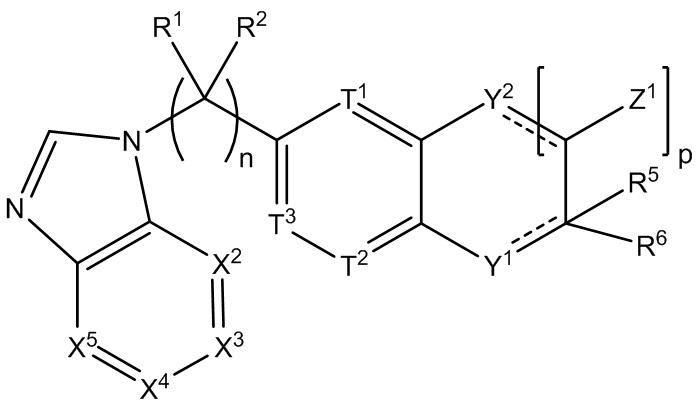FIELD: biochemistry.
SUBSTANCE: invention relates to a compound having the structure of formula (VII), or a pharmaceutically acceptable salt thereof, wherein the dashed lines represent optional double bonds and p is 1; n equals 1; X2 is N; each of X3, X4 and X5 is independently selected from CR7, wherein each R7 is independently selected from the group consisting of H, (C1-C10)alkyl, (C3-C10)cycloalkyl, (C3-C5)heterocycloalkyl, which means a non-aromatic group with 4-7 atoms that form one ring, where 3-5 ring atoms are carbon atoms and the rest of the ring atoms are selected from the group consisting of nitrogen and oxygen atoms, (C2-C5)heteroaryl in which 1 to 3 heteroatoms are selected from the group consisting of nitrogen and oxygen atoms, (C1-C10)alkyl-C(O)O-, (C1-C10)alkoxy-, (C1-C10)alkoxy-(C2-C9)heterocycloalkyl, R8-(C1-C10)alkyl-, R8-(C3-C4)heterocycloalkyl, which means a non-aromatic group with 4-6 atoms that form one ring, where 3-4 ring atoms are carbon atoms and the rest of the ring atoms are selected from the group consisting of nitrogen, monocyclic R8-(C2-C9)heteroaryl in which 1-3 heteroatoms are selected from the group consisting of nitrogen and oxygen atoms, R8-(C2-C10)alkynyl, R8-C(O)-, R8-(C1-C10)alkoxy-, (C3)heterocycloalkyl-O-, which means a non-aromatic group with 4 atoms that form one ring, where 3 ring atoms are carbon atoms and the rest of the ring atoms are selected from oxygen, R8-(C2-C9)heterocycloalkyl-O-, which means a non-aromatic group with 4 atoms that form one ring, where 3 ring atoms are carbon atoms and the rest of the ring atoms are selected from the group consisting of nitrogen and oxygen atoms, halogen, cyano, H2N-, (CH3)HN-, (CH3)2N-, F3C-, F2HC-, CH3F2C-, FH2C-, CH3FHC-, (CH3)2FC-; wherein each R8 is independently selected from the group consisting of H, (C1-C10)alkyl, (C3-C5)heterocycloalkyl, which means a non-aromatic group with 4-6 atoms that form one ring, where 3-5ring atoms are carbon atoms and the rest of the ring atoms are selected from nitrogen atoms, (C1-C10)alkyl-C(O)O-, (C1-C10)alkoxy-, HO-, halogen, (CH3)2N- and H2N-; where each (C2-C9)heteroaryl or (C2-C9)heterocycloalkyl is additionally optionally substituted with one to two groups selected from (C1-C10)alkyl, HO-, halogen or H2N-;wherein each of T1, T2 and T3 is independently selected from CR10, where each R10 is independently selected from the group consisting of H, (C1-C10)alkyl (C3-C10)cycloalkyl, (C1-C10)alkoxy-, HO-, halogen; where each (C1-C10)alkyl and (C3-C10)cycloalkyl is additionally optionally substituted with one to two groups selected from (C1-C10)alkyl, (C3-C10)cycloalkyl, (C1-C10)alkoxy-, HO-, halogen or H2N-; Y1 is O; R1 and R2 are independently selected from the group consisting of H, (C1-C10)alkyl, (C1-C10)alkoxy- and HO-; R5 is missing or selected from the group consisting of H, (C1-C10)alkyl and (C3-C10)cycloalkyl, and when the dashed lines on Y1 represent a double bond, R5 is missing; and R6 is selected from the group consisting of (C1-C10)alkyl, (C3-C10)cycloalkyl, (C1-C10)alkylamine, ((C1-C10)alkyl)2amine, R14-(C3-C10)cycloalkyl, R14-(C6)aryl, R14-(C3-C7)heteroaryl, in which 1 to 2 heteroatoms are selected from a group consisting of nitrogen, sulfur, and oxygen atoms, and R14-(C1-C10)alkylamine; where each R14 is independently selected from the group consisting of H, (C1-C10)alkyl, (C3-C10)cycloalkyl, (C6)heterocycloalkyl, which means a non-aromatic group with 6 atoms that form a single ring, in which 4 of the ring atoms are carbon atoms, and the rest of the ring atoms are selected from a group consisting of nitrogen and oxygen atoms, (C1-C10)alkylamine, ((C1-C10)alkyl)2amine, (C1-C10)alkoxy-, F2HC-O-, halogen, (CH3)2N-, F3C-C(O)-, F3C- и F2HC-; where each (C1-C10)alkyl, (C6)aryl or (C3-C10)cycloalkyl is additionally optionally substituted with one to two groups selected from (C1-C10)alkyl, (C3-C10)cycloalkyl or halogen; and each of Z1 is independently selected from H, halogen and (C1-C10)alkyl; Y2 is O, S, NR17 or CR17R18, wherein R17 is missing or each of R17 and R18 is independently selected from H or (C1-C10)alkyl. The invention also relates to a pharmaceutical composition based on these compounds as an inhibitor of the colony-stimulating Factor-1 receptor (CSF-1R).
EFFECT: obtaining new compounds and a pharmaceutical composition based on them that can be used in medicine for treatment of multiple sclerosis, amyotrophic lateral sclerosis, Huntington's disease, lupus, lupus nephritis and rheumatoid arthritis.
17 cl, 21 dwg, 6 tbl, 3 ex
 (VII)
(VII)
| Title | Year | Author | Number |
|---|---|---|---|
| NOVEL COMPOUNDS OF CONDENSED HETEROCYCLYL-CARBOHYDRAZONOYL DICYANIDES AND USE THEREOF | 2021 |
|
RU2826002C1 |
| TRICYCLIC JANUS KINASE 1 INHIBITORS, COMPOSITIONS, METHODS OF PRODUCTION AND USE THEREOF | 2019 |
|
RU2824349C2 |
| BENZOXAZEPINE PI3K INHIBITORS AND METHODS OF USE | 2010 |
|
RU2600927C2 |
| 2,3-DIHYDRO-1H-INDEN-1-YL-2,7-DIAZASPIRO[3,5]NONANE DERIVATIVES AND USE THEREOF AS GHRELIN RECEPTOR ANTAGONISTS OR INVERSE AGONISTS | 2011 |
|
RU2524341C2 |
| CONDENSED DERIVATIVES OF IMIDAZOLE AND PYRAZOLE AS MODULATORS OF ACTIVITY TNF | 2014 |
|
RU2687093C1 |
| CONDENSED TRICYCLIC IMIDAZOLE DERIVATIVES AS MODULATORS OF TNF ACTIVITY | 2014 |
|
RU2700004C1 |
| HETEROCYCLIC PYRAZOLE DERIVATIVES AS TYPE III RECEPTOR TYROSIKINASE INHIBITORS | 2020 |
|
RU2833004C2 |
| SUBSTITUTED IMIDAZOPYRIDINYL-AMINO-PYRIDINE COMPOUNDS, USEFUL FOR TREATMENT OF CANCER | 2010 |
|
RU2619463C2 |
| BENZOXAZEPINE PI3 INHIBITORS AND METHODS OF USE | 2010 |
|
RU2654068C1 |
| FUSED 1,4-DIHYDRODIOXIN DERIVATIVES AS INHIBITORS OF HEAT SHOCK TRANSCRIPTION FACTOR 1 | 2014 |
|
RU2671979C2 |
Authors
Dates
2021-06-01—Published
2016-07-19—Filed